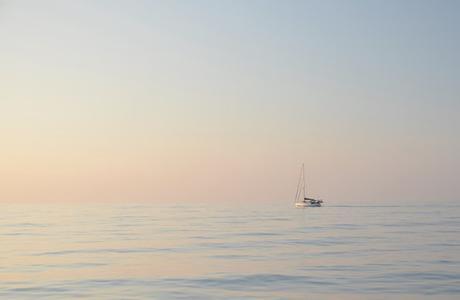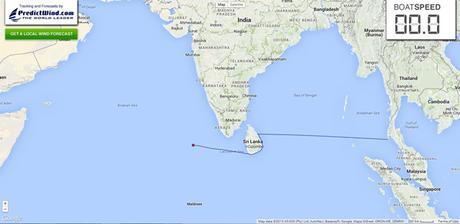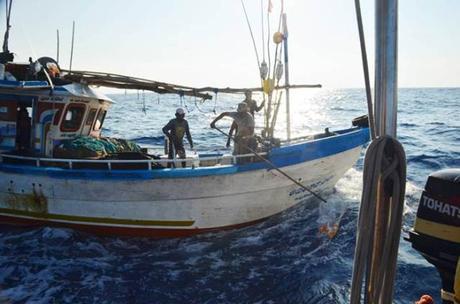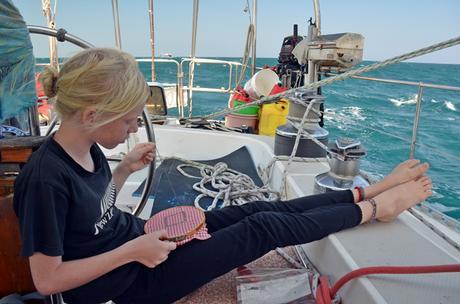
Why leave on a passage when there’s very little wind in the forecast? Having a breeze matters, when you have 700 miles to go. But the seasons are changing. It’s light, because that’s the shift in the seasonal pattern as the NE monsoon draws to a close. Waiting for wind isn’t necessarily going to bring us any wind. In fact, ideally, we’d be at least a month further into our Indian Ocean passagemaking at this point. But we wouldn’t leave Malaysia before we were ready. And we didn’t want to shortchange Sri Lanka. And both those were worth the tradeoff of adverse conditions now, since ‘adverse’ in this case doesn’t mean dangerous conditions- it just means no wind (or, upwind work going south in the coming weeks). And so we left Trincomalee with our diesel topped up, and the expectation of a slow trip.

Glassy water in Laccadive Sea; the Utopia was in visual range for the duration
It’s good to have the right expectations. Happily, we were able to sail for most of the first couple of days. On this passage we started tracking our position with PredictWind using automatic updates from our Iridium GO! on board. Very cool indeed! Here’s a zoomed out view of our the track looked after our arrival in Maldives, at which point we’re now closer to Somalia than we are to Malaysia. Kind of wild, really.

Our journey hugged the coast of Sri Lanka, and thermally driven breezes near shore helped us along the way. It also kept us close to the local fishing fleets, which made things…interesting!
During the day, and once at night, fishing boats approached us looking to trade. They ask for cigarettes and alcohol first; we don’t carry the former and wouldn’t admit to the latter, but most of them didn’t seem to care. They were an enthusiastic bunch, holding up fish they had to trade; a nice, not-TOO-big yellowfin tuna, a Spanish mackerel. We sent mango juice and packages of cookies across, and got some nice tuna sushi for lunch, and dinner, and lunch the next day.

At night, “interesting” has a whole new meaning. The thermals faded, and we motored through, which gave us a little more maneuverability through the fishing boats. This proved important, as there were plenty of them- and their nets! We were lucky not to catch any because despite having eyes on the water 100% of the time (barring bathroom breaks and watch changes), we still went over at least two nets. But in both cases, we were able to go into neutral before the floats bobbed past the transom, and thankfully nothing snagged.
Being approached by boats at sea can be tense. Being approached at sea in an area where others had bad experiences adds additional stress. But overwhelmingly, we heard good experiences about trading at sea with Sri Lankan fishermen. And I believe that overwhelmingly, people create the outcome they expect. One boat ahead of us described being “chased and searched” (searchlights) as boats tried to get close to him, and shone flashlights on them. We found the fishermen approaching Totem to be friendly and curious. They were assiduously careful *not* to touch Totem when we indicated they could approach, but used a long boathook so we could pass goods back and forth- you can see it in the photo above. At night, they shone searchlights our way to tip us off to their presence…and their nets. I felt no malign intent. Back in PNG, the boat we knew that kept getting robbed was the one with all the alerts and warning signs and the palpable distrust of the place and the people. Don’t underestimate the importance of attitude. That said, it was uncomfortable to be followed, literally for hours and hours at a time, by a fishing boat. Bored? Curious? I really think those are far, FAR more likely than any malicious intent.

Incredible sunsets at sea
Every passage includes something that breaks. And every passage seems to have at least one moment that makes your heart pound. On this passage, that breakage was the outhaul. Non-sailors, that’s the line that holds the bottom of the mainsail tautly out, back from the mast. Without it, the sail can go baggy and gets kind of useless…especially on a loose-footed main like ours (e.g., it’s not threaded through the boom, but open on top of it). Thankfully, conditions kept it mostly in place, we were able to wait on the fix, which is a fussy one to do while banging around at sea.
The adrenalin pumping event came on the third day, as we pulled away from the Sri Lankan coast. There were no squalls but a gray ridge overhead. Our radar picked up something that looked a lot like a microsquall, and then THIS formed… and then, a SECOND waterspout formed.

One of the two waterspouts, behind Utopia
It was truly terrifying. We scrambled into action, getting sails in and secured, making sure everything on deck that could possibly turn into a projectile was secured of moved below or sacrificial. And then we gunned it in the direction we felt provided the best evasive opportunity. It lasted for about twenty minutes, but felt like an hour. The International Centre For Waterspout Research picked up my tweet about the spout, and we found out their forecasting had anticipated the rare formation of waterspouts in this area, at the time we were passing through. I’m pretty fascinated by this and expect that we’ll be learning more about this organization and their services soon1
Mostly, however, this was an uneventful passage. We ate, we slept, we hung out in the cockpit cross stitching. Well, some of us.

There was a point where I never wanted this to end. We were sailing under the new moon- that is, no moon at all, and the inky dark nights hold a certain magic. So far from land-based light pollution, the stars are tremendous. Crossing the Laccadive Sea, we could see the North Star and big dipper to starboard, and the Southern Cross constellation to port. The last night, we drifted instead of motoring, letting the oily calm seas carry us along in the expanse of ocean.
Passagemakers and passagedreamers alike know we appreciate it when you read this on the Sailfeed website, and kick a little change in our cruising kitty. Thank you!

